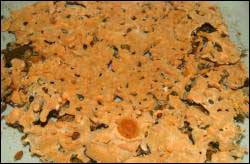Invasive sea squirt alive and well on Georges Bank

Image DSCF1526. Tunicate colony of a species of the genus Didemnum encrusting and cementing a pebble gravel seabed and crowding a dark orange anemone (lower part of photo). Note the relatively few holes in the mat where the gray background is visible. Northern Georges Bank (41 deg 54.429 min N lat, 67 deg 27.146 min W lon). Water depth 59 m (194 ft). November 2004. Width of specimen shown is 9 inches. Collectors: Page Valentine, Jeremy Collie, and Robert Reid. Photo credit: Dann Blackwood, U.S. Geological Survey.
The invasive sea squirt that federal and university researchers discovered on Georges Bank a year ago is flourishing in U.S. waters near the U.S.-Canada boundary, a joint research team announced today following a research cruise that concluded last week.
Scientists from the U.S. Geological Survey (USGS), the National Oceanic and Atmospheric Administration (NOAA), and the University of Rhode Island estimate that mats made of thousands of individual squirts infest a 40 square mile area of seabed that is highly productive for fish and sea scallops. In large parts of the affected area, the sea squirts cover 50 percent or more of the seabed. The Georges Bank infestation is unique, the only known occurrence of this magnitude in a major offshore fishing ground.
Sea squirts are tunicates, a type of sea life with a primitive spinal cord and a firm, flexible outer covering called a “tunic,” from which the name derives. A filter-feeding species of the genus Didemnum, they form dense mats, made of thousands of individuals, by attaching to firm substrates such as gravel, sea scallops, mussels, docks and other structures, and even seaweed. Tunicates can overgrow sea scallops and mussels, and they may affect other species of clams and worms that live in the seabed below the tunicate colony. An “invasive species” is one that is not native to an ecosystem, and that may harm that ecosystem if introduced.
In the fall of 2003, the same research team first spotted this infestation over roughly 6 square miles of ocean bottom during a scientific cruise to study habitats on Georges Bank. This year, the team surveyed a larger area with tunicate coverage.
The scientists observed mats over at least 40 square miles of the gravel substrate on the northern edge of Georges Bank. Video and photo transects using the USGS seabed observation and sampling system (SEABOSS) documented the distribution of the tunicate colonies in water depths of 42 to 65 meters (138 to 213 feet). The cruise was conducted aboard the NOAA Ship Delaware II.
Scientists will analyze data they collected on the cruise to determine if the tunicate invasion has the potential to alter seabed communities that sustain commercial fish species. Tunicate fragments were also found in the stomachs of haddock and winter flounder collected in the area, but did not appear to be digested. Samples of the tunicate will be evaluated to determine its nutritional value to predators, and to confirm the species through DNA analysis.
The tunicate can spread by reproducing either sexually or asexually by budding. The free-swimming tadpoles produced by sexual reproduction live only a few days, during which time they can be spread by tidal and storm currents to form new colonies. By contrast, fragments of colonies are long-lived. Controlled experiments in Cape Cod waters by USGS and Woods Hole Oceanographic Institution scientists have shown that small pieces removed from Didemnum colonies increase dramatically by budding in a matter of weeks. Thus, fragmentation of tunicate mats could promote the spread of the species.
The Didemnum species occurs along the coasts of the Netherlands and France. In the U.S., it has been documented in coastal New England from Connecticut to northern Maine, along the California coast, and in October of this year, it was first reported in Puget Sound off Edmonds, Washington. The same species (or a close relative) is present at several localities in New Zealand. Officials in Edmonds and in New Zealand have used chemical applications and physical removal in attempts to eradicate the relatively small infestations there.
The species thrives in marine environments that lie within its preferred temperature range (28 to 75 degrees F) and that have firm substrates and plentiful food, conditions that are widespread off the coasts of New England and Atlantic Canada. It could change gravel habitats that lie along the northern edge of Georges Bank, and immobile sand habitats characteristic of southerly Bank. Didemnum cannot survive on habitats of moving sand, and therefore much of the shallow Bank crest is not threatened. It is not yet known to occur on mud habitats that are typical of the deep basins of the Gulf of Maine.
Media Contact
More Information:
http://www.usgs.govAll latest news from the category: Earth Sciences
Earth Sciences (also referred to as Geosciences), which deals with basic issues surrounding our planet, plays a vital role in the area of energy and raw materials supply.
Earth Sciences comprises subjects such as geology, geography, geological informatics, paleontology, mineralogy, petrography, crystallography, geophysics, geodesy, glaciology, cartography, photogrammetry, meteorology and seismology, early-warning systems, earthquake research and polar research.
Newest articles

Parallel Paths: Understanding Malaria Resistance in Chimpanzees and Humans
The closest relatives of humans adapt genetically to habitats and infections Survival of the Fittest: Genetic Adaptations Uncovered in Chimpanzees Görlitz, 10.01.2025. Chimpanzees have genetic adaptations that help them survive…

You are What You Eat—Stanford Study Links Fiber to Anti-Cancer Gene Modulation
The Fiber Gap: A Growing Concern in American Diets Fiber is well known to be an important part of a healthy diet, yet less than 10% of Americans eat the minimum recommended…

Trust Your Gut—RNA-Protein Discovery for Better Immunity
HIRI researchers uncover control mechanisms of polysaccharide utilization in Bacteroides thetaiotaomicron. Researchers at the Helmholtz Institute for RNA-based Infection Research (HIRI) and the Julius-Maximilians-Universität (JMU) in Würzburg have identified a…



